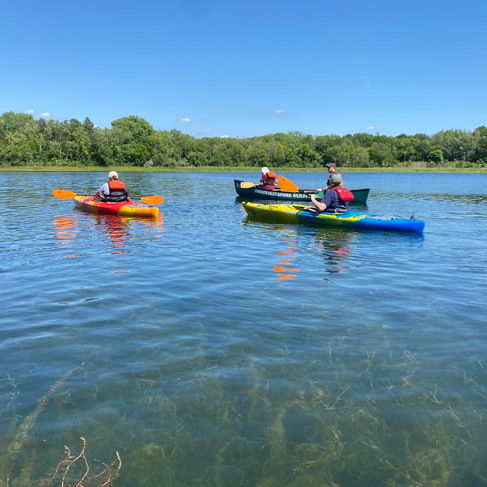To Minnesota and Back Again!
- bigoaksfriendsgroup
- Jul 31, 2023
- 5 min read
We just got back from the 2023 U.S. Fish and Wildlife Service Intern Workshop in Minnesota! For what was just a week of time, it certainly felt like it went by very fast. We got to meet with staff and peers from agencies all across the Midwest, and we learned about all the work they've been up to this season, which was as exciting as it was enlightening!
We even got to present about all the work we did here at Big Oaks this summer, which I enjoyed, since I find our work fascinating and love telling people all about it! (can you tell why they wanted me to handle the blog this summer?)

Yours truly giving a presentation on our work with the Henslow's Sparrow this summer!
Much of the workshop we spent attending seminars about all of the different federal programs within the USFWS and about how to go about applying for and being hired into positions within these programs. We also spent plenty of time meeting with representatives from each of these programs and hearing first-hand about the work that these people do. I myself had always been interested in the National Wildlife Refuge System, but hardly had any idea about what went on with other programs, such as Ecological Services or Partners for Fish and Wildlife, which both happened to catch my eye during the conference.

World Cafe meeting with USFWS staff! Each table had representatives from different programs, and we were able to spend some time listening and asking questions at each.
Both of these programs happen to work with federal, state, Tribal, local, and non-profit stakeholders, as well as with private land owners. Their objectives are to to avoid, minimize, and mitigate threats to our nation's natural resources, and to meet conservation goals set out by the USFWS. Prior to this conference, I had imagined that most federal biologists only cooperated with other state or federal agencies. I hardly had any idea about how much public outreach and cooperation these agencies performed in order to fulfill their conservation goals!
Not all of the conference was indoors, however. We had a few opportunities to get outside and visit the Minnesota Valley National Wildlife Refuge, which is a is a 14,000-acre urban National Wildlife Refuge located just south of the city of Minneapolis. During the middle of the week we also traveled to Bush Lake Park to do some outdoor workshops as well, including classes on law enforcement, migratory birds, archery, and canoeing! I might be speaking for myself here, but I think we all appreciated the chance to get out of the hotel and back into nature. It was very refreshing after all the presentations and meetings we had attended!
Conoeing at Bush Lake Park!
Classes in archery and law enforcement!
The adventure didn't stop after the conference was over though! On our way back home to Indiana, we made a couple stops in Wisconsin to visit with the Whitney Genetics Laboratory, and with the Upper Mississippi River National Wildlife and Fish Refuge! Both tours were led by people we met at the workshop in Minnesota, including Christina Stahl, who is the outreach specialist atthe Whitney Genetics Lab; and Quantit Ali, who is a wildlife biologist at the Upper Mississippi River NWR!
At the genetics lab, we learned about all the efforts going on around the Great Lakes to conserve lake sturgeon, paddlefish, and freshwater mussels. Invasive species of carp and mussels make it difficult for native species to compete in these habitats, since the invading wildlife reproduce very quickly and consume nearly all the food resources in the lakes to support their populations. Additionally, the construction of dams makes it nearly impossible for species like the lake sturgeon to reach their desired spawning habitats upstream, which each have a very unique suite of environmental conditions (shallow rivers with clear water and gravel or cobble bottoms free of silt and sand, with temperatures around 55 degrees Fahrenheit).
To monitor sturgeon in the lakes, each specimen introduced from the hatcheries is injected with a PIT tag (passive integrated transponder) that identifies them as individuals, and can be scanned whenever the fish is caught in order to record changes in size and condition. This helps the biologists at the lab keep track of the health of the sturgeon population both at large and at the individual level, and helps to inform management strategies for the USFWS. To keep track of invasive carp populations, the lab fits those fish with subdermal radio transmitters that emit signals which are captured by underwater recievers stationed all throughout the Great Lakes. This enables the lab to monitor the movements and distributions of the carp populations to better control them in the future.

Carp radio transmitter (small cylinder) and underwater reciever unit (big cylinder)
Outside of using this technology to inform management efforts, the lab's main focus is in the collection and processing of environmental DNA (eDNA) samples from the lakes and streams to determine the presence/absence of species in any given body of water. eDNA is nuclear or mitochondrial DNA that is released from an organism into the environment. Sources of eDNA include secreted feces, mucous, and gametes; shed skin and hair; and carcasses. By collecting water samples from the lakes, the lab can extract and then refine genetic information from the environment in order to determine, for example, which fish species are present there and in what amounts.
To prepare eDNA samples, water samples are collected in a capsule (top left), then the DNA is separated out after its run through a centrifuge (top right). The DNA is then removed and dried and run through the PCR technology (bottom left) to replicate the sample. Finally, the replicated genetic material is tested by the analyzer (bottom right) to determine what the species present are.
Though it's harder for me to envision myself in a laboratory setting than in a field setting, I still found the work being done at the Whitney Lab to be both interesting and exciting. Just like during the Minnesota workshop, I very much appreciated being exposed to lines of work that are separate from the career paths that I've been focused on pursuing for the past couple of years!
Meeting all of these professionals and touring different labs, parks, and refuges have all been instrumental in expanding my horizons and getting me to think about what work I'm really passionate about doing. I'm still focused on working as a biologist for the Fish and Wildlife Service, but I'm just now realizing how many different forms that goal can take outside of just being a wildlife biologist for a refuge.
As it stands, I've already learned very much about being a biologist from my experiences interning for Big Oaks this summer. Though the season is starting to wind down, I'm very much looking forward to the last couple of weeks I'll be spending here, and to all the exciting work I'll be doing in the near future after I'm gone!
Stay tuned for the next post! I've only got a couple of them left in me, and I plan to make them count!
- Maeve












































Comments